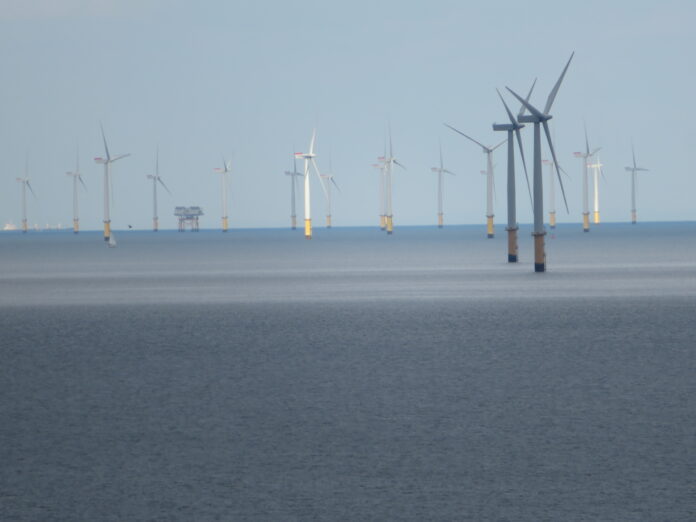
In the last two years, and including the 2024-25 proposed budget, the Welsh Government will have spent as much on Climate Change as on Education and the Welsh Language. Welsh education and health are the worst in the UK, itself lagging behind the rest of Europe. A ludicrous 12.7% of all Welsh Government spending, £8.62 billion pounds, will have been spent on tiny Wales ‘saving the planet‘. With 1,315,000 households, this equates to £6,555 (£2,185 per annum) per household in the poorest part of the United Kingdom. No other country in the world has such a budget. One wonders what would happen if voters realised that each household was contributing £42 a week for 3 years, to make little Wales a ‘world leader’. Wales is already smothered with intermittent energy windfarms, with the world’s largest turbines going ahead under the government’s strategic planning process.
One can only surmise that the billions have been spent building new domestic infrastructure to ease access for foreign firms that design and build wind towers, blades and motors overseas, then export them to Wales to be operated by foreign owners. Does the Welsh Government subsidize these companies? ‘Supporting renewable energy production’ is one of its claims. Every windfarm ever built in Wales is given the go-ahead by stating its maximum capacity, whereas the industry standard is around 25% efficiency. They are also said to ‘create green jobs’ – have you ever seen anyone at a windfarm? A successful onshore application is also said to supply, say, 10,000 local homes. However, because of their accepted efficiency rating, this is in fact around 2,500, with the energy supplied entering the National Grid, usually totally bypassing the affected locality. And only 35% of that energy goes to households, with industry taking 30%, and services at 29% being the next highest users. 35% of 2,500 is 875 homes, not 10,000 as accepted by planners. And politicians…
The UK emits less than 1% of global CO2 emissions, and on a population basis, Wales contributes just 4.6% of that total, or 0.02% of world output. (The actual figure will be much lower owing to the lack of industry across the nation). Wales could cease to exist, and it would make not a scintilla of difference to climate change. According to carbon briefing, ‘The UK has more than tripled its annual climate-finance spending from £392.5m in 2011/12 to nearly £1.40bn in 2022/23. In total, it has spent £12.63bn of development aid on ICF programmes across this period. This amounts to around 8% of total foreign-aid spending.’ Ignoring the monies wasted overseas, the UK has a population of over 67 million, which includes Wales’ 3.1 million. Strangely, the £2.81 billion spent by Wales in 2022-23 alone does not seem to be included in the UK total of just £1.40 billion from 2011-12 to 2022-23. We see Welsh Government expenditures below:
| £bn | 2021-22 | 2022-23 | 2023-24 | 2024-25* | 3 years
Inc 2024 -25 |
3 years % |
| HS | 9.06 | 10.13 | 10.98 | 10.69 | 31.80 | 46.6 |
| HG | 6.00 | 4.65 | 5.03 | 4.91 | 14.59 | 21.4 |
| CC | 2.81 | 3.03 | 2.78 | 8.62 | 12.6 | |
| ED | 1.88 | 2.57 | 3.43 | 2.68 | 8.68 | 12.7 |
| EC | 1.56 | 0.49 | 0.57 | 0.51 | 1.57 | 2.3 |
| EE | 0.72 | |||||
| RU | 0.39 | 0.48 | 0.48 | 1.35 | 1.9 | |
| MW | 0.32 | |||||
| SJ | 0.25 | 0.18 | 0.14 | 0.57 | 0.8 | |
| CS | 0.41 | 0.35 | 0.36 | 0.36 | 1.07 | 1.6 |
| TOTAL | 20.2 | 21.64 | 24.06 | 22.56 | 68.25 | 100% |
HS = Health and Social Services
HG = Housing and Local Government
CC = Climate Change
ED = Education (from 2022-23, Education and the Welsh Language)
EC = Economy and Transport
EE = Environment, Energy and Rural Affairs
RU – Rural
MW = Mental Health, Well-Being and the Welsh Language
SJ = Social Justice
CS = Central Services and Administration
CO = Covid 19
*Proposed Budget
It is informative to compare the Welsh spend of almost £3bn a year, to that of more wealthy, more populated and larger nations:
England has no dedicated climate expenditure, but just over £20 million was allocated to ‘Energy Security and Net Zero’ in 2022-23. For perspective, on average, Premier League football clubs spent £173 million on wages alone during the 2020/21 season, although the differences within the league are large.
Scotland has a ‘Transport, Net Zero & Just Transition’ budget of £4.864 billion for 2022-23, dropping to £4.527 and 4.575 for the following years. Of this for 2022-23 ‘Climate Change and Land Managers Renewables Fund’ receives £49.8 million, but the total transport, net zero and just transition budget also includes rail services (£2.139 billion), concessionary fares and bus services (£414 million), trunk road network (£877 million), ferry services (£296 million, rising to 440 million) and various other allocations. Suffice is to say that Wales, with a dedicated climate change budget of almost £3bn, far, far outspends its Scottish counterpart, which has 34% more people and is almost 4 times the size of Wales. Northern Ireland, like Switzerland and Austria, has no dedicated spending regarding climate, although the latter has a ‘green budgeting framework’, whatever that may mean.
France allocated 7.6 bn euros in 2022 on climate change, as agreed at COP26, but 2.4bn was to be spent in Africa and elsewhere so the domestic climate change budget was 5.2bn euros, c.£4.48bn, around 50% more than the Welsh total, and just 1% of the French total budget of 785bn euros, compared to Wales’ 12.6%. French population is 21 times that of Wales, yet its spending is only 50% higher, in a nation 26 times larger than Wales.
In Sweden, there are 27 different budget expenditure groups, and under the budget heading ‘climate, environment and nature’, 20 SEK billion (£1.536 bn) was spent in 2023, of a total budget of 1258 SEK billion, around 50% of what Wales commits to climate change alone. Forecasts for the following 3 years see this expenditure dropping as a % of overall spending. This is only 1.5% of total spending, as Sweden normally follows a conservative financial policy. Sweden has 3.4 times the population of Wales and is 22 times the size.
The Portugal 2022 budget included a €3.8 (£3.27) allocation of funds to combat climate change and for the environment, a 30% increase in relation to 2021. Portugal is now spending about the same as Wales, but also includes the environment in the climate budget. Portugal has over three times the population of Wales and is over four times larger.
An examination of European budgets showed no country demonstrating anything near the % of final budget spent on climate change by Wales. Some countries ignore climate altogether and others aggregate a smaller spend, comparable to Wales, in other budgets. The parlous state of relying upon renewables for electricity can be seen on the gridwatch website. At 10.40am on 12 January, our electricity was coming from:
Clean Gas 70%
Imports 10% (Interconnector supplies from France, Belgium, Netherlands, Norway)
Nuclear 7%
Wind 7%
Biomass 7% (The majority this is neither clean nor renewable in terms of forests being cut down and wood imported)
Coal 3% ( necessary in cold spells, along with imports)
Hydro 2%
Solar 1%
Exports 2% (To Eire and Northern Ireland. The Eire is building windfarms in Wales)
The 10% reliance on imported electricity via interconnectors points to the danger of those supplies being cut off in a Continental cold spell, with non-green’ biomass and coal making up another 10%, with imports making up a fifth of our electrical power. UK electricity costs to consumers, for many renewable-related reasons, are the highest in Europe. We have many years of gas supplies for electricity conversion in the North Sea, which would bring costs back to under a third of their present level, and help the Balance of Payments.
Terry Breverton BA MA CMC FIC FRSA FCIM FRHistS

| [donate]
| Help keep news FREE for our readersSupporting your local community newspaper/online news outlet is crucial now more than ever. If you believe in independent journalism,then consider making a valuable contribution by making a one-time or monthly donation. We operate in rural areas where providing unbiased news can be challenging. |


















